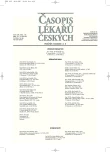Tělesné složení měřené pomocí DXA u pacientů s tyroidální dysfunkcí
The Assessment of Body Composition in Patients with Thyroid Dysfunction
Background.
Disturbed thyroid function is accompanied with weight changes in most of patients. Less is known how the therapy of hyperthyroidism and hypothyroidism influences their body composition.
Methods and Results.
We investigated 18 persons with newly diagnosed hyperthyroidism (group I), 15 persons with newly diagnosed hypothyroidism (group II), 22 persons with long-lasting well-controlled primary hypothyroidism (group II) and 17 persons with history of cured hyperthyroidism (group IV). Body composition, including percentage of body fat, was examined with Dual energy absorptiometry method (DXA; GE Lunar prodigy). There was no significant difference in age, BMI, and % of body fat between groups. Group I had mean levels of free T4 : 43.1±20.1 pmol/L, and TSH 0.03±0.05 mU/L. Mean values of TSH 28.55±20.64 mU/L and free T4 5.94±2.27 pmol/L were in accordance with the diagnosis of untreated hypothyroidism in group II. Thyroid function in groups III and IV was within normal limits. The mean weight gain in group I was 3.9 kg and their BMI increased from 25.78±3.73 kg/m² to 27.36±4.03 kg/m² after the therapy (p=0.023). BMI has not changed significantly in group II after the normalization of thyroid function, nor in group II and III. A significant parallel increase in the total body fat (26737±6993 g vs. 31277±8735 g), (p=0.0078) as well as in lean mass (43936±9886 g vs 51065±9501 g) (p= 0.0156) was observed only in group I after therapy. There was no increase in percentage of body fat (38.04±8.6% vs.38.0±9.8%) (NS). The body composition did not changed in the other patients treated during the follow-up.
Conclusions.
Normalization of thyroid function of newly diagnosed hyperthyroid patients caused the parallel increase in their fat mass and lean body mass, assed with DXA. Percentage of fat mass did not change significantly after the treatment. Correction of hypothyroidism did not lead to the body composition changes; patients did not show any weight loss either.
Key words:
body composition, DXA, percentage of body fat, thyroid function.
Autoři:
J. Brunová 1; P. Kasalický 2; V. Lánská 1
Působiště autorů:
Centrum diabetologie IKEM, Praha
1; Diagnostické centrum MEDISCAN–Euromedic, Praha
2
Vyšlo v časopise:
Čas. Lék. čes. 2007; 146: 497-502
Kategorie:
Původní práce
Souhrn
Východisko.
Tyroidální dysfunkce je u většiny pacientů provázena změnami hmotnosti. Méně je známé, jak léčba hyper a hypotyreózy ovlivňuje jejich tělesné složení.
Metody a výsledky.
Vyšetřili jsme 18 osob s nově zjištěnou hypertyreózou (skupina I), 15 osob se záchytem hypotyreózy (skupina II), 22 osob s dlouhodobě léčenou primární hypotyreózou (skupina III) a 17 osob s anamnézou předchozí léčby hypertyreózy (skupina IV). Tělesné složení včetně procenta tělesného tuku bylo vyšetřeno metodou dvojfotonové rentgenové absorbciometrie (DXA; GE Lunar Prodigy) . Skupiny se významně nelišily věkem, BMI ani % tělesného tuku. Ve skupině I byly průměrné hodnoty volného T4 43,1±20,1 pmol/l a TSH 0,03±0,05 mU/l. Hladiny TSH 28,55 ±20,64 mU/l a volného T4 5,94±2,27 pmol/l byly u skupiny II v souladu s dosud neléčenou hypotyreózou. Tyroidální funkce ve skupinách III a IV byla v normě. Průměrný váhový přírůstek skupiny I byl 3.9 kg a BMI vzrostl z 25,78±3,73 kg/m² na 27,36±4,03 kg/m² po léčbě (p=0,023). BMI se významně nezměnil u skupiny II po normalizaci jejich tyroidální funkce, ani u skupiny III a IV. Významný proporcionální vzestupu tukové (26737±6993 g vs. 31277±8735 g) (p=0,0078) i beztukové tělesné hmoty (43936±9886 g vs. 51065±9501 g) (p=0,0156) byl po léčbě zjištěn pouze u skupiny I. Procento tělesného tuku se u nich nezvýšilo (38,04±8,6 % vs. 38,0±9,8 %) (NS). Tělesné složení u ostatních pacientů se během sledované doby nezměnilo.
Závěry.
U nově zjištěných hypertyreózních pacientů došlo po normalizaci jejich tyroidální funkce k paralelnímu vzestupu tukové i beztukové tělesné hmoty hodnocené pomocí DXA. Procento tělesného tuku se nezměnilo. Léčba hypotyreózy nevedla ke změnám tělesného složení; u pacientů však nedošlo ani k poklesu tělesné hmotnosti.
Klíčová slova:
tělesné složení, DXA, procento tělesného tuku, tyroidální funkce.
Štítky
Adiktologie Alergologie a imunologie Angiologie Audiologie a foniatrie Biochemie Dermatologie Dětská gastroenterologie Dětská chirurgie Dětská kardiologie Dětská neurologie Dětská otorinolaryngologie Dětská psychiatrie Dětská revmatologie Diabetologie Farmacie Chirurgie cévní Algeziologie Dentální hygienistkaČlánek vyšel v časopise
Časopis lékařů českých

- Ukažte mi, jak kašlete, a já vám řeknu, co vám je
- Psilocybin a neurodegenerace: Kam míří současný výzkum?
- Isoprinosin je bezpečný a účinný v léčbě pacientů s akutní respirační virovou infekcí
- Metamizol jako analgetikum první volby: kdy, pro koho, jak a proč?
Nejčtenější v tomto čísle
- Bioekvivalenční studie léčivých přípravků v České republice
- Možnosti sledování aktivity eozinofilního zánětu u asthma bronchiale
- Stresová kardiomyopatie
- Je preskripce pohybové aktivity součástí léčebně-preventivní péče civilizačních chorob? Výsledky dotazníkového šetření lékařů
